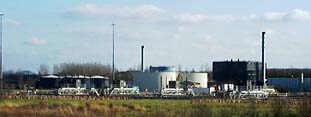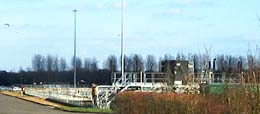




A sewage treatment plant is nothing more than a giant microbial culture breading facility, but in this case the microbes are persuaded to work for our benefit. They effectively use up unwanted nutrients in the system, by metabolizing the solid waste that passes through the treatment plant. The microbes oxidize the nutrients, and in the process energy, in the form of heat, and chemicals are produced - phosphates, nitrates and sulfates. The process is called mineralization. Gaseous by-products - carbon-dioxide are also produced.

Both aerobic and anaerobic microbes are used in the treatment process. In the first instance, aerobic microbes breakdown the nutrient-laden effluent. These are supplied with excess oxygen to promote vigorous reactions.
First, though, let us understand how a standard sewage processing system works. Sewage and waste water is conveyed to the processing plant though a series of large diameter pipes. The amount of liquid water, compared with solids, is high, and this is flow is necessary to ensure that the system continues to function without clogging up.

As the sewage enters a treatment plant the first process it encounters is a settling and large-scale filtering system that breaks up large solid matter, then allows any large floating objects to be skimmed off and dense non-organic matter such as sand and rock to settle out.
Water (and the effluent solids suspended in it) is taken from the settling tank and sprayed onto rock and block filter beds, through rotating pipes. The rock and block beds are home to a variety of microbes that include bacteria, algae, molds, protists, and the larvae of various insects and other arthropods. In the spray process, the air is oxygenated and this promotes vigorous activity in the filter bed. The suspended effluent solids are attacked and digested by the microbes.
The water now flows into an aeration tank. Here oxygen is bubbled through the effluent water and the mixture is vigorously stirred to ensure good aeration. Microbes brought into the tank from earlier processes multiply and digest the effluent, which, from here passes into a settling tank where any remaining solids are allowed to settle out. From here the water passes into a chlorination tank (where chlorine is added) and most of the remaining pathogens are killed, before the almost pure water is released into a river, lake or the ocean.
Note that the water is not pure enough to drink at this stage, though it is safe enough that it has no ill effects on the natural environment. This can only be assured when water is re-treated before being added to the public water supply. Also note that the sewage treatment plant does not remove industrial pollutants such as heavy metals or motor oil, both of which can actually damage treatment plants if in high concentrations.
The solid waste that is taken out from the settling tanks at various stages is known as activated sludge. It is alive with microbiological activity. Methane gas is given off, and this can be detected by your nose in the vicinity of sewage treatment plants!

The sludge is removed to large concrete vats that can be sealed. Excess effluent water is drained from the bottom of the vat. Anaerobic archaea microbes within the sewage are now allowed to work, breaking down all the organic matter. A sealed vat, though, will build up pressure and burst, from the methane given off by the microbes, so the gas is vented from the vat and in countries where energy is at a premium, is often used to power machinery in the sewage plant. Methane can be used as a fuel both in internal combustion engines (ie as in your car) and in gas turbines (as in an airliner). These engines can power pumps and sluices, generate electricity and even deliver the excess power into the electricity grid system. Thus your local sewage plant can be eco-friendly, by adding no net increase in greenhouse gasses or other pollutants to the environment. It also allows a certainty of power supply to the treatment plant, for it is not at the mercy of electricity grid or public gas supply. A failing sewage plant is potentially more hazardous than almost any other type of civic amenity save perhaps a nuclear power plant. It must keep working at all costs.
Up to 50% of the sludge can be digested in the vats, but once the process starts to wane the vats are emptied and the waste material can be spread out on the ground to dry in shallow concrete pits. Once this has happened the material can be collected, bagged, and sold as land fertilizer. It is safe to handle and extremely effective in the fields, provided it is free from industrial pollutants. Much more is produced, however, than can be used on local land, and disposal of sludge in city areas is a world-wide problem.
For
more information see Water
Microbiology from Washington State University.
Go
to
Home
| Space Station
| Mars | Rainforest
© 1999 Satellite Events Enterprises Inc.